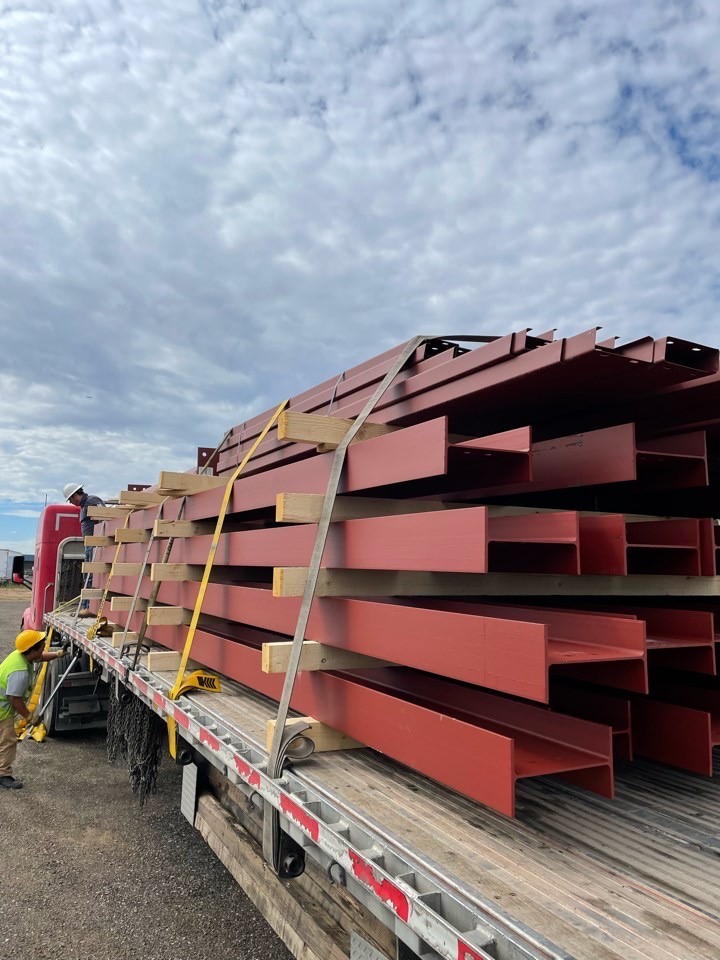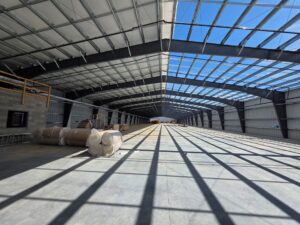From Plant to Project: Delivering Metal Buildings on Time
by David Flaherty | 22 October 2025 11:38 am
 [1]
[1]Metal buildings offer several key advantages for construction projects: off-site prefabrication, efficient assembly, and the delivery of a fully enclosed, weather-tight solution. Unlike traditional stick-built or custom-fabricated structures, metal building systems are selected for speed, capability, and convenience. These packages can be coordinated to meet precise project specifications before delivery, providing a comprehensive, turnkey envelope. For owners, general contractors, or project managers working with a metal building contractor, the process is easy when executed correctly. This article provides a detailed overview of ordering, scheduling, and delivering a metal building to an active construction site.
Communication is key
Project success relies on effective communication and planning during the pre-construction phase. For metal buildings, lead times are crucial; they can range from eight to 22 weeks depending on project complexity, plant capacity, and order readiness. Of those three items, project complexity and plant capacity are straightforward, but order readiness needs to be discussed. Explain why order readiness is crucial to a pre-engineered metal building (PEMB) delivery schedule. Before the COVID pandemic, steel prices remained steady, allowing for adaptable project pricing, scheduling adjustments, and changes within a relatively stable market environment. Since the pandemic, manufacturers have adopted stricter policies regarding scheduling and delivery, requiring complete certainty of orders and categorizing projects as either approval or production. Approval jobs follow a design and build process involving budget pricing, approval drawings for the design team, and permit drawings. These tasks are completed outside of the fabrication schedule; once approval is obtained, the project is repriced based on current market rates before being added to the fabrication queue. As previously mentioned, production orders refer to orders ready for fabrication. They represent the fastest route to on-site delivery; however, it is essential to confirm all order details before submission, as production orders generally do not allow modifications, additional time for approval drawings, or schedule adjustments in the same way approval orders do. This approach enables quicker project delivery and maintains the initially quoted price, which depends on the manufacturer. For this article and the rest of the delivery and scheduling standards, it is assumed that a medium complexity production order is being fabricated and making its way on-site in 12 to 14 weeks.
Next steps
The project team has signed a purchase order with a metal building contractor and paid the deposit. The metal building is being engineered, fabricated, and delivered on-site for the project. It is easy! Up next is to look at what this means for the manufacturer and contractor. Upon receipt of the signed purchase order and deposit, the procurement team initiates orders for all required materials—including metal panels, roof panels, plates, hot-rolled and cold-formed steel—according to the specified gauges, colors, and accessories for the project. Each order may consist of up to 50 distinct components. At this stage, a project coordinator or manager is assigned to oversee collaboration across departments and to provide both the contractor and customer with a comprehensive schedule of deliverables. Typical milestones are as follows: anchor bolt and reaction drawings, a complete permit set, final erection drawings, and delivery schedules, sometimes including phased deliveries, which we will touch on later.
Finalizing the design
The manufacturer’s designer finalizes the design and works closely with the team to move into detailing; subsequently, these details are submitted to engineering for final approval. Shop drawings are then signed off and stamped before fabrication. Throughout this process, approximately a dozen individuals are involved before the project reaches the production floor. Once this happens, 15 or more team members contribute to each project. On average, the project manager coordinates over two dozen professionals to ensure readiness for project delivery. Upon completion and assembly of all parts and components, manufacturers typically collaborate with local trucking companies to facilitate loading and delivery to the project site. Considering these factors, production orders must be prepared for fabrication. Changes made by an owner or design team during the process will result in costly fees, project delays, additional rework, or occasionally require restarting the entire process. From the perspective of a metal building contractor or erector, it is essential to maintain ongoing communication with the project manager. Teams must thoroughly review all relevant documents within limited timeframes to ensure alignment with the project team’s design, prepare necessary submittals, and coordinate for timely delivery, unloading, and inventory of the project materials. These tasks require careful attention and are not without their challenges.
Deciding on the type of delivery
Before discussing on-site delivery, it is helpful to outline the three types of deliveries: sole-source delivery, delivery of buy-out items, and phased deliveries. Sole-source delivery refers to projects where all steel, paneling, and accessories are supplied from one factory. Typically, this comes via a set number of trucks, with all materials delivered to the site simultaneously for complete assembly. Delivery of buy-out items involves sourcing specific components separately; in these cases, the contractor or erector coordinates these additional deliveries according to the construction sequence. Phased delivery is applied in large projects, multiple buy-out items, or scheduling constraints. This method can be negotiated with some manufacturers based on project requirements. For instance, for projects exceeding 9,290 m2 (100,000 sf) with limited laydown area, manufacturers may collaborate with contractors and clients to schedule phased deliveries of primary steel, roof and wall sheeting, and insulation according to the construction sequence and available space on-site. These factors all tie back to the importance of up-front communication with the project team to facilitate a successful project.
The day of delivery
 [2]
[2]Once the delivery method has been determined, review best practices for on-site deliveries and outline the standard requirements that the owner or site manager should coordinate to ensure efficient unloading and material storage. Designating a single point of contact between truck drivers and the on-site contractor or erector is necessary for coordinating vehicle entry, establishing timeframes for unloading, and managing egress, all of which are important to project safety and operational efficiency. Manufacturers typically provide the driver with a hard copy of the bill of materials (BOM), sometimes referred to as a “shipper”; it is also good practice to request a digital version of the master list from the manufacturer. On-site personnel use the BOM to verify the delivered components for fabrication quality and inventory tracking. Confirming that all items listed have been received in full is crucial. In the case of missing or damaged goods, obtain photographic evidence (preferably while items are still on the truck) and promptly notify the manufacturer to arrange replacement parts. Ensure that proper unloading equipment is used, as referenced in the erection manual from the manufacturer (i.e., telehandlers, cranes, rigging, and appropriate safety measures). The equipment must be used when transferring materials into a secure, clean, and conveniently located laydown area, preferably adjacent to the building pad. Deliveries and site traffic should be managed according to a logistics plan submitted by the contractor/erector and reviewed by the project team to support a successful start to construction.
Common issues include late design changes (as production orders lack flexibility for revisions); insufficient site readiness (such as a lack of a graded laydown area, gravel, or water mitigation plan); insecure storage (if laydown areas are not fenced or covered, increasing theft risk); and unclear delivery methods. Poor communication on these items remains the most significant risk to project success.
Again, communication is key
In closing, it all starts with clear communication of expectations, goals, and processes from order readiness to fabrication and lastly site delivery. Considering site conditions, available on-site real estate, and clear communication with the manufacturer and contractor are paramount to setting the stage for a successful project.
As a Baylor graduate and Class A general contractor, Justin Beall steered DD Construction to specialize in the metal building industry. He is a board member of the Metal Building Contractors and Erectors Association (MBCEA) and an active member of the IAS Accreditation Committee that oversees the AC478 program, among other things
- [Image]: https://www.metalconstructionnews.com/wp-content/uploads/2025/10/Photo-2.jpg
- [Image]: https://www.metalconstructionnews.com/wp-content/uploads/2025/10/Photo-1.jpg
Source URL: https://www.metalconstructionnews.com/articles/delivering-metal-buildings-on-time/